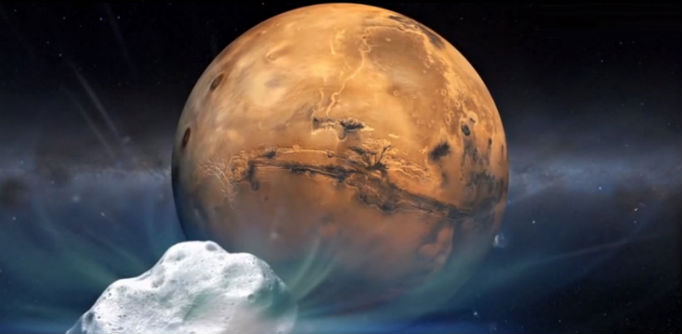Rare comet fly-by of Mars on Sunday

This artist’s concept illustration provided October 14, 2014 by NASA depicts the Comet Siding Spring (2013 A1) and Mars. On October 19, Comet Siding Spring, a comet that has traveled many billions of miles, will come within about 87,000 miles of Mars, about one-third of the distance of the Moon from Earth. AFP PHOTO / HANDOUT / NASA
WASHINGTON–A fast-moving comet is about to fly by Mars for a one-in-a-million-year encounter with the Red Planet, photographed and documented by a flurry of spacecraft, NASA said.
The comet, known as Siding Spring (C/2013 A1), has a core about a mile (1.6 kilometers) wide in diameter, but is only as solid as a pile of talcum powder.
Siding Spring is set to hurtle past Mars at a close distance of about 88,000 miles (139,500 kilometers).
If the comet were passing by our planet, that would be about a third of the way between the Earth and the Moon.
Siding Spring will come closest to Mars at 2:27 pm (1827 GMT) on Sunday, October 19, NASA said.
Flying through space at a breakneck speed of 122,400 miles per hour (202,000 km per hour), the small comet faces little risk of colliding with the Red Planet.
But scientists are keen to study its trajectory and trail.
“Are we going to see meteors in the Mars atmosphere? Comets are very unpredictable,” said Jim Green, director of the Planetary Science Division at NASA headquarters in Washington.
“I think it is unlikely that it will be destroyed,” Green told reporters. “But whether it retains its structure or not is of interest.”
NASA has maneuvered its Mars orbiters to the far side of the planet so they won’t be damaged by the comet’s high-speed debris.
Even as the Mars Reconnaissance Orbiter, Mars Odyssey and MAVEN have been repositioned to avoid hazardous dust, scientists hope they will be able to capture a trove of data about the flyby for Earthlings to study.
NASA’s two rovers — Curiosity and Opportunity — will turn their cameras skyward and send back pictures of the comet’s pass in the coming days, weeks and months, the US space agency said.
Billions of years old
The comet was discovered by Robert McNaught at Australia’s Siding Spring Observatory in January 2013.
It is believed to have originated billions of years ago in the Oort Cloud, a distant region of space that is a source of comets that are “largely unchanged since the early days of the solar system,” NASA said.
Carey Lisse, senior astrophysicist at Johns Hopkins University Applied Physics Laboratory, said scientists are intrigued by comets for many reasons.
“It is amazing that they are still around after four and a half billion years, but most of the reason for that is they have been living very, very far from the Sun and are in a deep freeze,” he said.
This particular comet is about the size of a small mountain, but is probably the consistency of powder, or a meringue that would melt in your mouth, he explained.
“It should have more of the really volatile ices — methane, carbon monoxide — things that boil off very easily. It has never been heat treated very strongly before.”
Scientists say they are curious to learn if the comet may have already broken up some on its approach to Mars.
“There is a possibility that Mars may drive some more activity, that is why we are looking,” Lisse said.
The comet has traveled more than one million years to make its first pass by Mars, and will not return for another million years, after it completes its next long loop around the Sun.